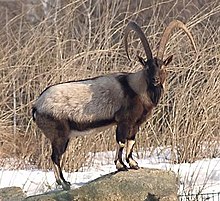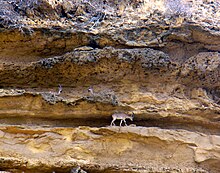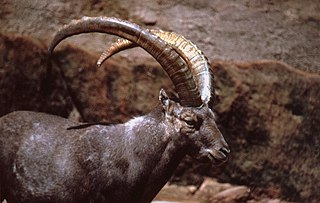
An ibex is any of several species of wild goat , distinguished by the male's large recurved horns, which are transversely ridged in front. Ibex are found in Eurasia, North Africa and East Africa. The name ibex comes from Latin, borrowed from Iberian or Aquitanian, akin to Old Spanish bezerro, 'bull', modern Spanish becerro, 'yearling'. Ranging in height from 70 to 110 centimetres (27–43 in) and weighing 90 to 120 kilograms (200–270 lb) for males, ibex can live up to 20 years. Three closely related varieties of goats found in the wild are not usually called ibex: the markhor, western tur, and eastern tur.

Capra is a genus of mammals, the goats, comprising ten species, including the markhor and several species known as ibexes. The domestic goat is a domesticated species derived from the bezoar ibex. Evidence of goat domestication dates back more than 8,500 years.
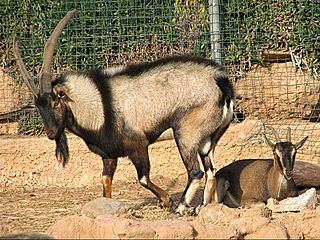
The Kri-Kri, sometimes called the Cretan goat, Agrimi, or Cretan Ibex, is a feral goat inhabiting the Eastern Mediterranean, previously considered a subspecies of wild goat. The Kri-Kri today is found only in Greece; specifically on three small islands off the shore of Crete, as well as on the island of Sapientza, which was brought there in great numbers in order to protect the species from extinction.

The West Caucasian tur is a mountain-dwelling goat-antelope native to the western half of the Caucasus Mountains range, in Georgia and European Russia. It is listed as Endangered on the IUCN Red List, as the wild population is estimated to be between 5,000 and 6,000 individuals.

The Nubian ibex is a desert-dwelling goat species found in mountainous areas of northern and northeast Africa, and the Middle East. It was historically considered to be a subspecies of the Alpine ibex, but is now considered a distinct species. The wild population is estimated at 4,500 mature individuals, and it is classified as vulnerable.

The Caucasus mixed forests is a temperate broadleaf and mixed forests ecoregion in the Caucasus Mountains, as well as the adjacent Lesser Caucasus range and the eastern end of the Pontic Mountains.
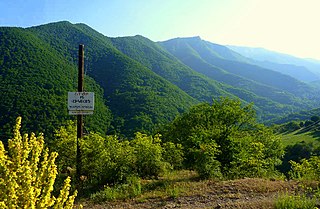
Shikahogh State Reserve is Armenia’s second largest forest reserve, covering some 10,330 ha of land, and located in southern Armenia in the Syunik Province. Environmentalists have said it has been largely unaffected by Armenia’s massive post-Soviet deforestation due to its remote location and care shown by residents of nearby villages.

Panthera pardus tulliana, also called Anatolian leopard, Persian leopard and Caucasian leopard in different parts of its range, is a leopard subspecies that was first described in 1856 based on a zoological specimen found in western Anatolia. It is native to the Iranian Plateau and the surrounding region from eastern Anatolia and the Caucasus to the Hindu Kush, where it inhabits foremost subalpine meadows, temperate broadleaf and mixed forests and rugged ravines at elevations of 600 to 3,800 m. It preys mostly on ungulates reliant on these habitats.

The Armenian mouflon is an endangered subspecies of mouflon endemic to Iran, Armenia, Nakhchivan Autonomous Republic of Azerbaijan, Turkey and Iraq.
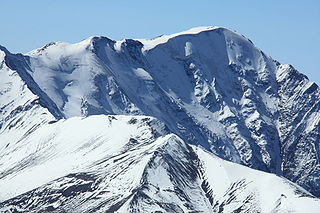
Shahdag National Park — is a national park of Azerbaijan. It was established on an area of 115,900 hectares (1,159 km2) in the Quba Rayon, Qusar Rayon, İsmayıllı Rayon, Qəbələ Rayon, Oğuz Rayon and Şamaxı Rayon administrative districts on December 8, 2006. It was enlarged by presidential decree on July 8, 2010 from 115,900 hectares (1,159 km2) to 130,508.1 hectares (1,305.081 km2).

The feral goat is the domestic goat when it has become established in the wild. Feral goats occur in many parts of the world.

The bezoar ibex is a wild goat subspecies that is native to the montane forested areas in the Caucasus and the Zagros Mountains.

The Sindh ibex or Turkman wild goat is a vulnerable subspecies of wild goat endemic to southwest Pakistan, and southeast Iran.
The Chiltan ibex or Chiltan goat is a wild goat endemic to Chiltan, Balochistan, Pakistan.
The Turkmen wild goat or bearded goat is a vulnerable sub-species of wild goat native to Iran and Turkmenistan. Turkmen wild goats are present in scattered populations in the central Kopet Dagh along the border between Turkmenistan and Iran between, and in the Large Balkhan (Bolshye) north of Nebit Dagh. It is closely related to domestic goats. As of 1986, their total population was estimated to be 7 000, and decreasing.
Sarcocystis is a genus of parasitic Apicomplexan alveolates. Species in this genus infect reptiles, birds and mammals. The name is derived from Greek: sarkos = flesh and kystis = bladder.
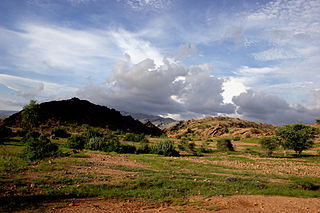
The Kirthar National Park is situated in the Kirthar Mountains in Jamshoro District in Sindh, Pakistan. It was established in 1974 and encompasses over 3,087 km2 (1,192 sq mi), making it the third largest national park in Pakistan. Wildlife in the park comprises leopard, striped hyena, Indian wolves, honey badger, urial, chinkara gazelles and rare Sindh ibex. Blackbuck are kept in enclosures for a reintroduction project.

The Eastern Anatolian deciduous forests ecoregion is located in the mountains of eastern Turkey. It is a Palearctic ecoregion in the temperate broadleaf and mixed forests biome.
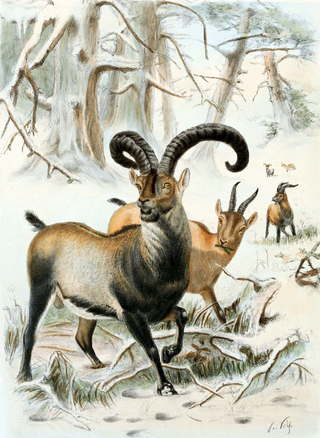
The Pyrenean ibex, Aragonese and Spanish common name bucardo, Basque common name bukardo, Catalan common name herc and French common name bouquetin, was one of the four subspecies of the Iberian ibex or Iberian wild goat, a species endemic to the Pyrenees. Pyrenean ibex were most common in the Cantabrian Mountains, Southern France, and the northern Pyrenees. This species was common during the Holocene and Upper Pleistocene, during which their morphology, primarily some skulls, of the Pyrenean ibex was found to be larger than other Capra subspecies in southwestern Europe from the same time.

Pshav-Khevsureti National Park is in Dusheti Municipality, Mtskheta-Mtianeti region of Georgia. Park has been established by direct involvement of World Wide Fund for Nature.
